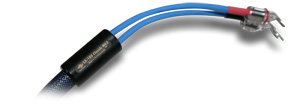 |
| June 15, 2006 Siltech SQ-110 Classic Mk 2 Interconnects and LS-188 Classic Mk 2 Speaker Cables
What’s new about the Mk 2s For many manufacturers, "Mk 2" means slight tweaks ranging from fiddling with a product’s appearance to small internal changes. Major changes usually get entirely new names and/or numbers. But Siltech’s president, Edwin van der Kleij, is one of those rare birds who is constantly tinkering with his existing product line, adopting new techniques and features that make significant improvements. The "Mk 1" Classic wires and cables used a geometry Siltech called X-Balanced Micro-Technology, based on the fifth generation of the firm’s silver-gold metallurgy, which uses 24k gold to fill gaps in the crystals of the pure silver wires. (A sixth generation is available that uses even more gold filler, but that’s Siltech’s top product line, Gen 6. I haven’t heard those wires; the Gen 5s kept me happy enough not to worry about it.) X-Balanced Micro-Technology uses two solid-core conductors that are insulated with Kapton, an exceptional, albeit expensive, very thin, hard insulator made by DuPont. The conductors are then twisted very tightly around each other, making the angle of approach very close to 90 degrees -- which Siltech says causes the magnetic fields to cancel -- the tightly wound pair becoming like a single wire. This assembly is then inserted in a tube of synthetic material that damps mechanical vibrations and reduces microphonics. Finally, the outside of the tube is fully covered by a silver shield. The Mk 2s use a more sophisticated geometry, Dual-Balanced Micro-Technology. The same conductors and Kapton insulation are used, but before they’re wound together Siltech puts each dedicated silver-gold conductor and its layer of Kapton into a full-coverage braided silver shield, then adds Teflon insulation. The conductors are then wound together so that their magnetic fields cancel each other out. Siltech claims that because each conductor is individually shielded, this configuration results in lower distortion, vastly improved conductivity, and dramatically improved rejection of RF noise. But remember what I said about Edwin van der Kleij’s obsession with continual improvements? Now he’s come up with a process that involves heating the wires, and requires new machinery not yet available in the US. Siltech is based in the Netherlands; their products are distributed (and some are assembled) in the Western hemisphere by its American partner, Siltech America. Wires made with the new Siltech Advanced Thermal Treatment (SATT) process can be made only in Holland until the new machinery comes online in the US, probably in 2007. Siltech claims that the SATT process yields significant improvements with the Signature and Classic Mk 2 cables. It's now standard on their elite Signature series and is a special-order option for the lower-cost Classic Mk 2 series, where the added price of $400 becomes proportionately significant. Potential buyers of the SQ-110 or the LS-188 Classic Mk 2 cables most likely won't be deterred by the $400 upcharge for the SATT process, making it a viable option for them. My review samples are the non-SATT versions stocked in the US for quick delivery, but Siltech's claims of improved performance for cables with the SATT process have piqued my curiosity and I look forward to the opportunity to hear them. The sound of the Mk 2s I inserted various lengths of SQ-110 Mk 2 interconnect and LS-188 Mk 2 speaker cable into a reference system that included a Denon Exemplar DVD-3910 universal player, Metronome Signature transport and DAC, Wyetech Opal preamplifier, Jadis JA-80 monoblock amplifiers modified with Siltech internal wiring, Von Schweikert VR-4 Gen III HSE speakers, and various accessories, led by the indispensable Vibrapod Isolators and Cones. The wire connecting the Metronome transport to its DAC was Siltech’s HF-10 Classic, and their Classic SPX-30 Mk 2 AC cables joined earlier versions of Siltech power cords to complete an all-Siltech-wired system. When I listened to other CD players through the Classic wires and cables -- both the originals and the Mk 2s -- I could distinctly hear each player’s character. That applied, too, to small (or what some may think are small) tweaks, such as using Vibrapod Isolators with and without Vibrapod cones under the source components. I remember the original Siltech Classics as being the quietest wires I’d ever had in my system. Though I couldn’t conduct a direct comparison, the Mk 2s were, as claimed, even quieter. This from someone who lives in the RF heaven of midtown Manhattan, subject to intense wireless bombardment and the dubious electrical services of Consolidated Edison. Obviously, I was interested in trying to determine how much, if any, the Mk 2 versions differed from the original Classics I’d lived with back in 2004. Just as obviously, even to attempt this amounted to folly -- aural memory is notoriously short-lived, making valid, detailed comparisons impossible. But I was willing to settle for a rough guess, based on fallible aural memory and a dose of imagination grounded in the consistency of Siltech’s sound, which bears a familial resemblance throughout its cable line. And because the only change in my basic reference system since 2004 was the addition of the Denon Exemplar DVD-3910, I figured it was worth a shot. After a lengthy period of listening for pleasure, I began the review process by listening to the same CDs I’d used to review the original SQ-110 Classic interconnect and LS-188 cable. As expected, the Siltech family sound shone through. That sound is fast -- the transients on Benjamin Britten’s Young Person’s Guide to the Orchestra [JVC JVXR 0226] were as fast as I remembered them. It’s also extended -- JVC’s transfer of Fritz Reiner and the Chicago Symphony’s recording of Bartók’s Concerto for Orchestra [JMCXR-0007] had deep bass and sparkling highs, not to mention the realistic string sound I relish. Other discs revealed the detail I long for without the bright overlay that often accompanies highly detailed recordings. Turning to material that did not find its way into that original review, I played an old favorite, Un’ Ottava Sottosopra’s Live Recital [CD, musicaimmagine 10015]. This is a hard-to-find Italian import of a concert given by a double-bass quartet riffing on jazz, pop, and classical standards, including a hilarious 2.5-minute take on an arrangement they call "Beethoven’s Fifth Bossa Nova." It’s great for depicting the instrument’s dark, woody sound, the range and rich possibilities of the harmonics and octaves four basses can produce, as well as the atmosphere of the venue -- a jazz club -- and the placement of the instruments on stage. The Siltechs did it all -- I could practically see the instruments, their sound was so resonant; the "live" setting was so realistic I felt like looking for a waitress to ask for another beer. This recording has always sounded impressive in my system, but never more so than through the Classic Mk 2s. More audiophile thrills came from a Carnegie Hall concert of Schubert four-hand piano music played by Evgeny Kissin and James Levine [CD, RCA 69282]. The treble notes were vibrant without glare or harshness, the wide dynamics multi-layered and nuanced, the hall sound realistic. This disc has often been heard chez moi since its release, but I’d never before heard it sound so lifelike and full of bloom. I’ve now played literally hundreds of discs through the Siltech Classic Mk 2s. The well-recorded ones revealed their strengths as never before. Others had their flaws out in full view, not obscured by euphonic warmth or exaggerated by treble glare. And even those routine discs that fall well below the audiophile’s radar had their shortcomings revealed without dimming those aspects of recording the engineers got right. Conclusion
Some might say Siltechs tend to be slightly on the warm side of neutrality. But with ears conditioned by regular attendance at Carnegie Hall, I’d describe their sound as neutral, refusing to err either on the side of humid warmth or on the side of the deep freeze often heard from digital. To a greater degree than most other wires and cables I’ve heard, the Siltechs conveyed a satisfying image depth as well as an ease of presentation I can only call natural -- like what I hear at Carnegie. That means there was a liquidity, a flow from note to note, that was like the real thing. Obviously, this will also depend on the rest of your system. In the grand climaxes of orchestral and operatic music, my setup loses some of that easeful presentation for want of more powerful amplifiers. But I could hear that, too, through the Siltechs -- they accurately reflected the character of the hardware in my system The Classic Mk 2s represent an improvement over the originals, though I can’t describe the gain as a precise percentage. Given the Mk 2s’ cost, if I had the originals I probably wouldn’t -- and couldn’t -- upgrade. But that won’t matter to those who need wires now and can afford top-of-the-line gear. The Siltech SQ-110 Classic Mk 2 and LS-188 Classic Mk 2 would be at home in virtually any high-end system. They should be on anyone’s short list of wires and cables to audition for a touch of Audio Heaven. …Dan Davis Siltech SQ-110 Classic Mk 2 Interconnects and
LS-188 Classic Mk 2 Speaker Cables Siltech B.V. E-mail: siltech@soundmirror.com
Siltech America, Inc.
Ultra Audio is part of the SoundStage! Network. |
 Back in July 2004,
I reviewed the
Back in July 2004,
I reviewed the  So here I am, once
again wallowing in the sound of wires from Siltech, watching the clock tick away, each
movement of the second hand bringing me closer to the dreaded moment when they must be
packed up and shipped back to their makers -- unless a rich uncle dies and leaves me a
fortune. Unfortunately, I lack a rich uncle, or any other potential benefactor among
family, relatives, and friends.
So here I am, once
again wallowing in the sound of wires from Siltech, watching the clock tick away, each
movement of the second hand bringing me closer to the dreaded moment when they must be
packed up and shipped back to their makers -- unless a rich uncle dies and leaves me a
fortune. Unfortunately, I lack a rich uncle, or any other potential benefactor among
family, relatives, and friends.